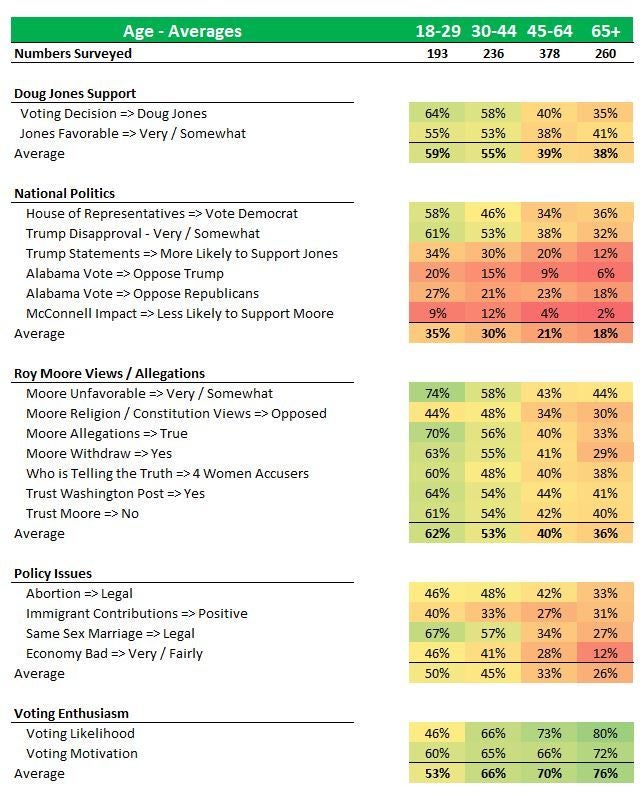Republished from Breaking / Bannon.
This article is the 2nd essay in a 3-part series on the opinion polls and demographic dynamics that give Doug Jones this unprecedented opportunity for a Democrat to win a statewide election in Alabama. You can view the other 2 essays here and here.

Cross-tabs from recent CBS News and Gravisopinion polls for the December 12 special Senate election in Alabama allow us to identify key demographic slices of the electorate who could play a significant role in the outcome of the race. Consider the table below, that break out Alabama voter preferences and attitudes by age (with comparable possibilities for building tables of preferences and attitudes for Alabama voters distinguished by gender, education, race, and religious status).
Election Outcomes and Non-Linear Thinking
In both CBS News and Gravis polls, a wide preference gap separates voters under the age of 45 from those over the age of 45. Among younger voters, an average of 61% plan to vote for Doug Jones, compared to an average of 38% for older voters. While 52% of younger voters hold a favorable opinion of Doug Jones, compared to only 39% of older voters.
However, this chasm extends beyond support for Doug Jones among younger voters, interlacing a cluster of related opinions concerning national politics, opinions of and allegations against Roy Moore, and policy issues. At the same time, older voters are significantly more likely to vote and motivated to vote than younger voters.
Analysis of these various electoral dynamics, specifically in the context of the unique circumstances of the Alabama Senate election, requires some non-linear thinking. The payoff for this kind of analysis is insight into flexible range of possibilities (and explanations for) election outcomes that defy conventional wisdom. Consider below, for a moment, the patterns in the table of personal and policy preferences for this election, and then we can briefly explore their implications.

Demographic Dynamics and Data Dimensions
In the aggregate, about 52% of younger voters surveyed for the CBS News and Gravis Marketing polls support Doug Jones and moderate-to-liberal policy positions concerning abortion, same-sex marriage, immigration, and the economy. Only about 31% of older voters support Doug Jones and these moderate-to-liberal policy positions.
Similarly, about 45% of younger voters actively oppose and mistrust Roy Moore, believe the women who accused him of predatory sexual behavior when he was in his 30s, and disagree with his theocratic and scriptural perspective on legal and constitutional matters. These younger voters also dismiss the national Republican Party apparatus that now supports Roy Moore’s candidacy for the Senate, even in the wake of these disturbing allegations. Only about 29% of older voters similarly align themselves against Roy Moore and the national Republican Party.
In general, the consistent trend is for younger voters to favor Doug Jones and oppose Roy Moore, across all dimensions of the personal and political landscape, at rates about 60% higher than older voters. These trends further intensify at the extremes, with voters aged 18-29 favoring Doug Jones and opposing Roy Moore at rates about 80% higher than the oldest voting cohort, those aged 65 and over.
While these trends might indicate a leverage point for the Doug Jones campaign, the enduring realities of electoral interest and voting turnout, disclosed in the Voting Enthusiasm section of the table, suggest otherwise. Along the dimensions of voting likelihood and voting motivation, younger voters are about 25% less likely than older voters to actually follow through on election day, with this gap increasing to 40% less likely when comparing the 18-29 year old group to the 65+ group. When factoring in these propensities, the age-driven voting gap would seem likely to wipe out most (although not all) of the edge Doug Jones obtains from voters under the age of 45.
There are also simply fewer young people eligible to vote. In the state of Alabama, about 47% of the adult population is under 45. The CBS poll further underweights this population, with only about 40% of its sample falling into the under-45 age cohort. So how do we interpret this information? That is a story for the 3rd essay in this series.
